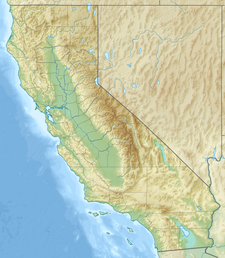The Bolam Glacier is a glacier situated on the northern flank of Mount Shasta, in the U.S. state of California.[2][3] It is the second longest glacier in California behind the nearby Whitney Glacier, and the fourth largest and most voluminous after the neighboring Hotlum Glacier, Whitney Glacier, and Wintun Glacier.[4] The Bolam Glacier flows from a cirque on the north side of Mount Shasta's main summit, with the moving ice starting below a large bergschrund which spans the glacier at 12,600 ft (3,800 m).[5] Above that, permanent snow and ice extends towards the summit to about 13,500 ft (4,100 m).[5] The glacier flows north down a steep slope and terminates near 9,800 ft (3,000 m).[5] It has a contributing drainage area of 1.03 km2.[6]
| Bolam Glacier | |
|---|---|
| Type | Mountain glacier |
| Location | Siskiyou County, California, U.S. |
| Coordinates | 41°24′55″N 122°12′02″W / 41.41528°N 122.20056°W[1] |
| Area | 2 sq mi (5.2 km2) |
| Length | 1.4 mi (2.3 km) |
| Thickness | 70 ft (21 m) average |
| Terminus | Moraine |
| Status | Expanding |
In 2002, scientists made the first detailed survey of Mount Shasta's glaciers in 50 years. They found that seven of the glaciers have grown over the period 1951–2002, with the Hotlum and Wintun nearly doubling, the Bolam increasing by half, and the Whitney and Konwakiton Glaciers growing by a third.[7][8][9] Due to rising global temperatures, as of 2007, alpine glaciers and rock glaciers are shrinking across the western United States.[10]
See also
editReferences
edit- ^ "Bolam Glacier". Geographic Names Information System. United States Geological Survey, United States Department of the Interior. Retrieved September 30, 2012.
- ^ "Existing Glaciers of Mount Shasta". College of the Siskiyous. Archived from the original on March 7, 2007. Retrieved January 23, 2007.
- ^ "Glaciers of California". Glaciers of the American West. Glaciers Online. Archived from the original on September 3, 2006. Retrieved 2007-01-23.
- ^ Driedger, Carolyn L.; Kennard, Paul M. (1986). "Ice volumes on Cascade volcanoes; Mount Rainier, Mount Hood, Three Sisters, and Mount Shasta". U.S. Geological Survey Professional Paper 1365. Retrieved March 6, 2007.
- ^ a b c Google Earth elevation for GNIS coordinates
- ^ Fegel, Timothy S. (March 29, 2016). "The Differing Biogeochemical and Microbial Signatures of Glaciers and Rock Glaciers". Journal of Geophysical Research: Biogeosciences. 121 (3): 919–932. doi:10.1002/2015JG003236 – via PDXScholar Library.
- ^ Harris, Stephen L. (2005). Fire Mountains of the West: The Cascade and Mono Lake Volcanoes (3rd ed.). Mountain Press Publishing Company. p. 109. ISBN 978-0-87842-511-2.
- ^ Wong, Kathleen. "California Glaciers". California Wild. California Academy of Sciences. Archived from the original on October 6, 2006. Retrieved 2007-01-23.
- ^ Whitney, David (September 4, 2006). "A growing glacier: Mount Shasta bucks global trend, and researchers cite warming phenomena". The Bee. Archived from the original on January 21, 2007. Retrieved 2007-01-23.
- ^ Diaz, Henry F. (September 27, 2007). "Disappearing "alpine tundra" Köppen climatic type in the western United States". Geophysical Research Letters. 34 (18): L18707. doi:10.1029/2007GL031253.
